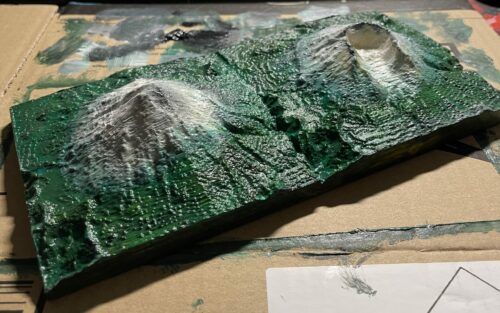In most cases, 3D printed models for teaching visually impaired learners are printed in one colour. At the moment, the majority of 3D printers work with only one nozzle, so the models are therefore not multicoloured. If the models are used with sighted pupils, colours quickly play a decisive role. The special solution of changing colours at different heights is described in article 5 General Cura advices. Often, however, neither this special trick nor a two-colour print using a printer with two print nozzles is sufficient.
Skilful colouring, i.e. the use of strong contrasts, is essential for good perceptibility of these models. However, the printed models can also be coloured relatively easily afterwards.
The following article refers to the painting of models made of PLA, as this is the plastic most commonly used in our context. Fortunately, the process described also works with models made of other plastics such as ABS or PET-G.
Basically, the painting process is divided into the following steps:
- preparing the model
- priming
- painting
- finishing
1. preparing the model
Depending on the quality of the print, the model can first be smoothed or sanded. Both techniques are described in article 7.1 Smoothing PLA. The better the printed model has been prepared for painting, the better the end result will be. When preparing the model, first of all try to remove any irregularities. These will remain visible even after colouring, so this step should be carried out carefully. Depending on the desired quality of the finished model, a layer of spray filler can be sprayed onto the model, which must then be sanded after drying. This layer can be sanded better than the PLA model itself . Please note: whether these steps are needed depends very much on the quality of the print. A normal print without traces of the support material, stringing etc. does not necessarily need to be processed.
2. priming
If the entire model is to be coloured and not just a few details highlighted, you should prime the model first. Priming creates a homogeneous surface, which can then be painted more easily and more evenly. Small defects in the surface can be remedied using this step.
As the entire surface is to be covered with a thin layer, primers that can be sprayed on are often the best choice. Depending on the model’s size, it should be fixed on a stand. It is important to ensure that the 3D model is free of dust and grease before applying the primer. It is also important that the primer does not accumulate on the model or form drips. After drying, it is better to spray on a second coat rather than making the first coat too thick. Repeat the sanding and priming process until the desired level of smoothness is achieved. The solvents in the primer can also cause the model to warp if the primer is applied too thickly.
A bright primer (grey or white) is helpful to get shining colours afterwards.
Primers can also be applied with a brush. Just be careful that you don’t apply it too thickly. Also, the solvents in spray paint can affect your 3D print. Your print may distort if too much spray paint is applied.
3. painting
When painting, you have to decide whether the model should be painted using a brush, pens, spray cans or an airbrush. Regardless of the technique, it is advisable to use acrylic paints, as they adhere and cover well and are also water-soluble.
Brushes or pens should generally be suitable for most users, as often only details such as dots or line symbols are to be coloured. Brushes, however, can also be used to colour larger areas. As a particularly artistic result is not necessary in the school context, if the surface is not completely smooth, this is not too problematic. This paint and these brushes have proved their worth, although products from other manufacturers can of course also be used.
To make two colours tactilely distinguishable, sand can be added to one of the colours. The bonding is not perfect, but with a subsequent varnish it is pretty durable.
Acrylic pens can also be used to colour in small details. Theoretically, using permanent markers also works. Unfortunately, the colour tends to run along the individual layers, which is why it is better to refrain from this technique.
As with all painting jobs you can use masking tape to protect certain parts of your print from getting sprayed on or to get sharp lines.
4. finishing
The models that are printed and coloured for non-sighted and visually impaired learners are usually intended to be held and touched. Scraping with fingernails but also simply constant touching can cause acrylic paint to easily peel off, even if it has been primed beforehand. Therefore, it is useful to spray on a transparent varnish after painting. Gloss varnish can create unpleasant reflections, so a matt varnish is recommended.
The following example shows Hurricane Katrina, which was transferred into a 3D model on the basis of 12 satellite images. The model was printed in one colour as yellow PLA. The printed model was painted using acrylic paint and pencils, and was neither prepared nor primed.
The following model shows a three-dimensional topographic map of the volcano Mount St. Helens before and after the eruption in 1980 (faithful reproduction) while the painting process. Blind and visually impaired students can thus visually and tactilely understand the change of the crater after one of the most powerful volcanic eruptions of the 20th century.



